- Title: Contemplations, 'Ψ'.
- Author: Arvindus.
- Publisher: Arvindus.
- Copyright: Arvindus, 2021, all rights reserved.
- Index: 202104131.
- Edition: html, first edition.
§
The Greek character 'Ψ' ('Psi') regards graphically a trident. And when in possession of the Greek mythological god Poseidon the trident, and through its graphical resemblance also 'Ψ', symbolizes emotion. Poseidon, the lord of psi, is the lord of emotion.1
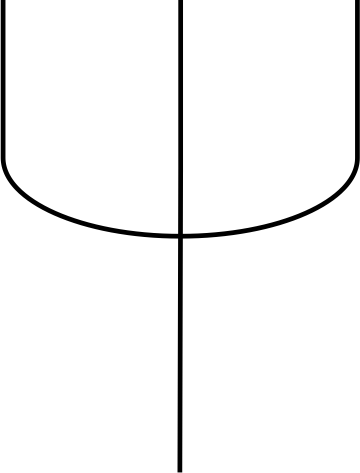
Figure 1.
Graphically the figure consists of three vertical lines that are connected by a bended horizontal line, on top of a fourth vertical line. When divided in an upper and a lower part the figure resembles a ninety degrees turned over Arabian numeral '3' put on top of an Arabian numeral '1'. When put unturned next to each other the number '13' is formed, and when the space between these numerals is removed the shape of a butterfly seen from the side appears. Now since the butterfly is a symbol of the soul or consciousness principle can 'Ψ' be taken as a symbol of the soul as well.2
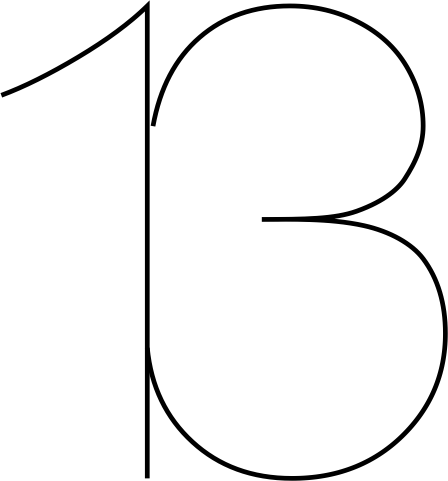
Figure 2.
Continuing this graphic play with the numbers '3' and '1' of 'Ψ' we may also extend the outer lines of a turned over '3' towards the bottom of an erect '1'. In this manner a heart with in it a horizontal line appears. The '1' can however also be reduced to a singular point to which then the two outer lines of '3' are connected, resulting in a clean heart shape. Such a heart shape is a very well-known symbol of love, being the prime quality of the soul,3, 4 so the analogy holds.

Figures 3, 4.
Now those who see in 'Ψ' a graphic representation of the unification of the feminine with the masculine are not on a wrong track. For in the ageless wisdom the number '1' relates to spirit and masculinity and the number '3' to matter and femininity.5, 6 Together this father and mother form a child, which as the child principle regards the so called 'Christ principle', being the consciousness principle or the soul.7, 8, 9 So also from this angle 'Ψ' comes to symbolize the soul.
The dual 'Ψ' can however not only be seen as consisting of the numbers '1' and '3' but also of the Roman characters 'E' and 'I', in line with the Greek 'Ε' and 'Ι' (or 'ε' and 'ι'). Taken together these characters form the vowel sound 'ει' which is found in the Greek pronunciation of 'ψει' or 'psei'.10 With these characters again the butterfly shape can be formed which can be taken to symbolize the soul.
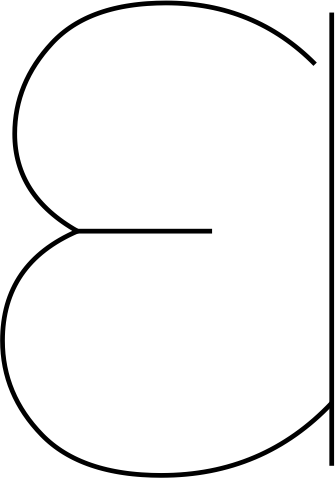
Figure 5.
Another way to interpret the dual graphic 'Ψ' symbol of the phonetics of 'psi' or 'psei' is by letting the lower part stand for the vowel 'I', leaving the upper part to represent the consonant(s) 'ps'. Independently however it is difficult to link the sound 'ps' to the graphic representation of the upper part of 'Ψ'.
Now the upper part of the 'Ψ' character can also be read as a 'W' or when flipped as an 'M'. The 'W' and 'M' are both derived from the prime symbol of water, matter and motherhood, just as the 'F' (or 'P(h)') is related to notions like fire, spirit and fatherhood.11 This 'F' can be seen as a mirrored '1' like the 'W' and 'M' can be seen as turned over '3's. And thus we see 'Ψ' also from this angle again consisting of a masculine and a feminine aspect, forming together the Christ child of the soul.
| Father | Mother |
| Spirit | Matter |
| Fire | Water |
| 1 | 3 |
| F / P | W / M |
Figure 6.
So 'Ψ' has both aspects of the father and the mother in it, but as the child principle it has an independence of its own. And loose from 'Ψ' ('Psi') the principle of matter is often symbolized by the Greek character 'Χ' ('Chi'). This 'Χ' regards graphically a cross consisting of two diagonal lines.
Christians use this 'Χ' in combination with the Greek character 'Ρ' ('Rho') and form them together into the chi-rho monogram that symbolizes Christ. On the one hand that symbolism is phonetic because 'Χ' and 'Ρ' regard the first letters of the name 'Christ'. And on the other hand that symbolism is graphic. For the ellipse of 'Ρ' is taken to symbolize the spirit of God that is then crucified on the cross of matter, which is symbolized by 'Χ'. So the chi-rho monogram symbolizes Christ as the spirit that is crucified on matter or as the Word that has become flesh.12, 13
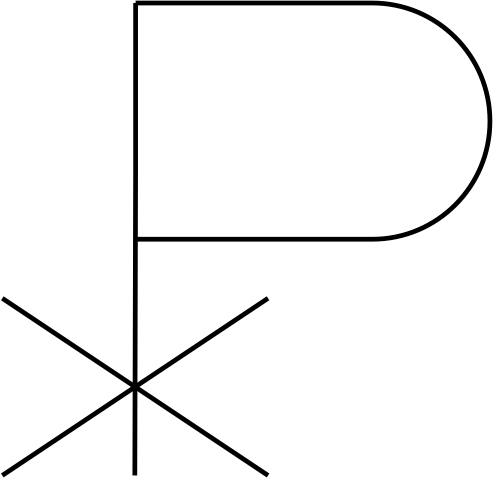
Figure 7.
This 'Χ' as symbol for the cross of matter is in application however not confined to the chi-rho monogram, for it can also be applied to 'Ψ' through which a psi-chi monogram comes to being. This psi-chi monogram then does not symbolize the on the cross of matter crucified spirit but the on the cross of matter crucified soul. It does not symbolize the Word that has become flesh but the soul that has become flesh. It symbolizes the soul in incarnation.14
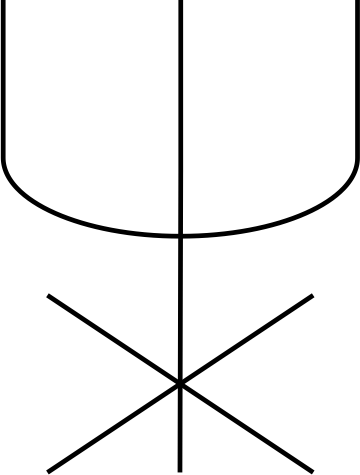
Figure 8.
Now this 'psi-chi' can in English be read as 'psyche'. And written with a capital 'Psyche' is the name of a Greek mythological lady that is in art depicted with butterfly wings. This signifies thus that the psyche is psi in flesh, the soul in incarnation.15 The esoteric philosophy of the Master Djwhal Khul through Alice Bailey explicates similar views and the logo of the publisher of the regarded oeuvre, Lucis Trust, also contains a psi-chi monogram.
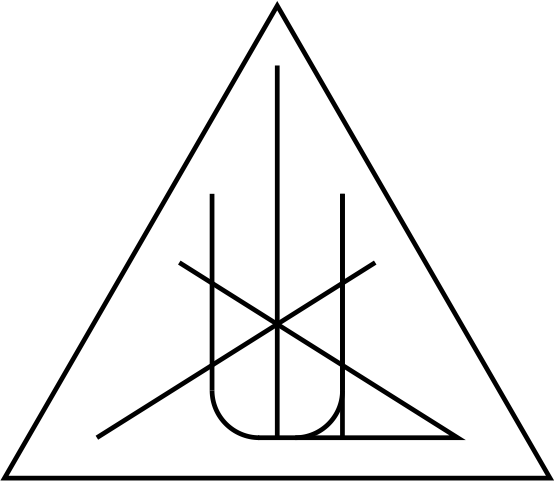
Figure 9.
Another psi-chi monogram is also used as a symbol of the planet Neptune, which as a mythological god is the Roman equivalent of the Greek Poseidon. This symbol we see again consisting of a trident, of 'Ψ', and a cross at its base, this time consisting of a vertical and a horizontal line.16
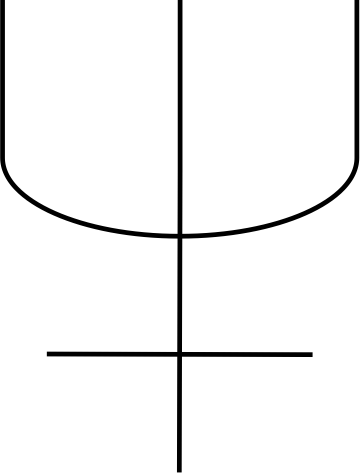
Figure 10.
Where however with the lady Psyche 'Ψ' symbolizes the soul there does it with the god Poseidon or Neptune symbolize emotion. For besides water being a symbol of matter it is also a symbol of emotion, and Poseidon or Neptune is primarily a god of the waters. Thus it is mentioned that 'Ψ' most basically signifies the transformation of personal emotion into the intuition of the soul, making the psi-chi monogram symbolizing this process taking place in human incarnation.17
| Symbol | Principle | Personification | |
| Ρ | Spirit | God the Father | |
| Ψ | Soul | Transformation of emotion into intuition | Christ |
| Emotion | |||
| Χ | Body / matter | ||
| ΧΡ | The Word in flesh | Christ | |
| ΨΧ | Soul in body | The psyche | Psyche |
| Emotion in body | Poseidon | ||
Figure 11.
Now such a straight cross in a psi-chi monogram is also used in the Christian Sacred Heart symbol, where in this case the straight cross is depicted on top of the '3' and '1' combination of psi (being the heart shape).
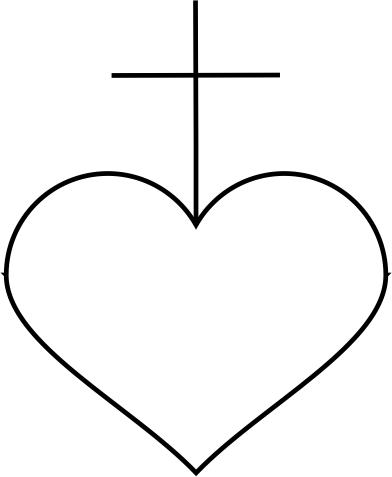
Figure 12.
This Sacred Heart monogram is also contained in the symbol that is used by Mayil Publishing House, the publisher of the works of the Master Morya through Geert Crevits. Here the vertical line runs all the way through the heart shape untill its bottom unifying point. When the dome shape on top then is seen as a modified ellipse this symbol may even be considered as containing a modified psi-chi-rho monogram.
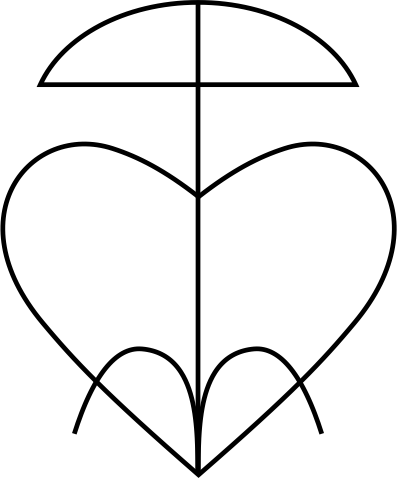
Figure 13.
Let us then with this consideration conclude this contemplation on 'Ψ'.
Notes
- 'Contemplations, Psi', Index: 202103171.
- Ibidem.
- Alice A. Bailey, Esoteric Healing, A Treatise on the Seven Rays, Volume IV, in: Twenty-Four Books of Esoteric Philosophy, (CD-ROM), Lucis Trust, London / New York, 2001, p. 165. "The heart, the love-wisdom of the soul, the buddhi or Christ principle."
- Geert Crevits, Morya Wijsheid 1, Bewust handelen, Mayil Publishing House, 2007, p. 125, translated. "Love always goes through the heart, that is the unifying power between the different oppositions in man."
-
Alice A. Bailey, The Light of the Soul, in: Twenty-Four Books of Esoteric Philosophy, (CD-ROM, Release 3), Lucis Trust, London / New York, 2001, p. 6. "a. The Law of Economy......the law governing matter, the third aspect.
b. The Law of Attraction...the law governing soul, the second aspect.
c. The Law of Synthesis....the law governing spirit, or the first aspect." - Alice A. Bailey, A Treatise on Cosmic Fire, in: Twenty-Four Books of Esoteric Philosophy, (CD-ROM, Release 3), Lucis Trust, London / New York, 2001, p. 1019. "There is no contradiction here to the occult teaching that Father and Mother, or Spirit and Matter, when brought into contact, produce the Son."
- Ibidem.
- 'Ageless Wisdom, Triplicities in Man', Index: 201308292.
- 'Ageless Wisdom, The Age of the Mother of the World', Index: 201702251.
- Oxford English Dictionary, Second Edition on CD-ROM (v. 4.0), Oxford University Press, 2009, psi1.
- 'Contemplations, An Etymosophy of 'Father' and 'Mother'', Index: 201501261.
- 'Contemplations, Etymological and Esoteric Roots of 'Arch', 'Arc' and 'Ark'', Index: 201103261.
- The American Standard New Testament, (software), Version 1.0, Ages Software, Albany, 1996, John, Ch. 11, v. 14. "And the Word became flesh, and dwelt among us (and we beheld his glory, glory as of the only begotten from the Father), full of grace and truth."
- Nota 1.
- Ibidem.
- Ibidem.
- Ibidem.
Bibliography
- 'Ageless Wisdom, The Age of the Mother of the World', Index: 201702251.
- 'Ageless Wisdom, Triplicities in Man', Index: 201308292.
- 'Contemplations, An Etymosophy of 'Father' and 'Mother'', Index: 201501261.
- 'Contemplations, Etymological and Esoteric Roots of 'Arch', 'Arc' and 'Ark'', Index: 201103261.
- 'Contemplations, Psi', Index: 202103171.
- Alice A. Bailey, A Treatise on Cosmic Fire, in: Twenty-Four Books of Esoteric Philosophy, (CD-ROM, Release 3), Lucis Trust, London / New York, 2001.
- Alice A. Bailey, Esoteric Healing, A Treatise on the Seven Rays, Volume IV, in: Twenty-Four Books of Esoteric Philosophy, (CD-ROM), Lucis Trust, London / New York, 2001.
- Alice A. Bailey, The Light of the Soul, in: Twenty-Four Books of Esoteric Philosophy, (CD-ROM, Release 3), Lucis Trust, London / New York, 2001.
- Geert Crevits, Morya Wijsheid 1, Bewust handelen, Mayil Publishing House, 2007.
- Oxford English Dictionary, Second Edition on CD-ROM (v. 4.0), Oxford University Press, 2009.
- The American Standard New Testament, (software), Version 1.0, Ages Software, Albany, 1996.